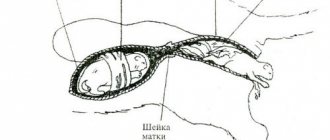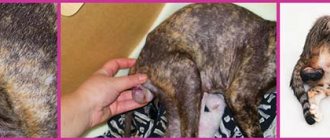5384Administration
A newborn kitten is always a joy for all inhabitants of an apartment or house. You need to prepare for it in advance. Despite the fact that a cat knows at the genetic level how to survive in nature, it is not always able to survive this process on its own. Therefore, every cat owner should know what to do if the cat cannot give birth.
There are cases when, if help was not provided, a pet began to die from various complications. This usually affects artificially bred breeds that have undergone changes at the genetic level and cannot reproduce normally. Therefore, they are not able to cope with what ordinary yard animals can easily cope with.
© shutterstock
What to do if a cat cannot give birth?
During a normal birth, the cat does not require any significant assistance from a person. It is enough to leave her in a calm, secluded environment.
With pathological births, you cannot hope that a little more time will pass and the cat is about to give birth. If the process deviated from the norm, then it means that a certain reason contributed to this. If more than 24 hours have passed since the onset of the first contractions, then such a birth can be called pathological.
This condition indicates that the absence of contractions and pushing can cause the death of not only kittens, but also the cat herself.
What you should absolutely not do:
- Use medications to induce contractions.
- Press on the cat's belly to push the kittens through.
- Give an intense massage.
If labor lasts within 15 hours, but you are already starting to panic, and also see that the animal is exhausted and the intensity of labor pains has decreased, then you can resort to the following methods of assistance:
- Place the cat on the floor or sofa and stroke its belly and back very gently. This way the animal will calm down and prepare for childbirth.
- If the kitten is stuck in the birth canal already at the exit , then you need to help the cat and pull out the cub. This procedure should be done extremely carefully, without rushing. It is strictly forbidden to pull the kitten by the head or paws. This can injure not only the pet, but also the cat’s birth canal, causing severe bleeding. It is best to pull by the folds of skin that are on the neck or torso.
- If the cat is tired , then offer her something to eat. Any cat's favorite treats will do.
- If the kitten, when being born, first showed its paws , then do not rush to pull it out. Gently push the baby back. So, the animal will have the opportunity to change its body position. In just a minute the kitten will be born correctly - head first.
Don't listen to advisers!
Cat lovers forums are filled with advice on what to do if your cat is unable to give birth. If we summarize all the advice, it turns out that the only way to help a young mother is to start injecting Oxytocin.
Oxytocin has been regarded for many years as a dangerous drug, the use of which is only relevant in extreme cases. Do not use medications that have not been prescribed by your veterinarian. During prolonged labor, a veterinarian must be called to your home and all recommendations given to him must be followed.
The cat does not give birth for the second day - what to do?
What to do if the cat cannot give birth on the second day? This situation is critical and indicates the owner’s lack of awareness in matters of cat birth.
If the cat's contractions have disappeared, but she has become lethargic, apathetic and weak, then this indicates the beginning of the inflammatory process. In this case, the kittens are already dead and the owner needs to urgently deliver the pet to the clinic to save its life. In this case, surgical intervention is indicated.
Signs of the onset of labor
A day before the onset of labor in a cat, the signs that appeared earlier are supplemented by another - a decrease in body temperature by 1°C. If the pet is accustomed to regularly measuring its temperature, then this method will help determine as accurately as possible the approach of delivery. If this procedure is new to the owner and the mother in labor, it is better not to start it at such a moment, but simply leave the animal alone.
Before you give birth to a cat, you must prepare a “rescue” set of tools and equipment, including:
- antiseptic and disinfectant;
- scissors, dental floss;
- pipette, baby syringe, disposable syringes
- surgical gloves
- gauze napkins;
- petrolatum;
- toilet paper;
- garbage bags;
- diaper;
- heater;
- stopwatch.
You should also have the veterinarian's phone number at hand. All this may not be necessary, but it is better to prepare for any development of the situation.
The immediate beginning of the labor process will be indicated by rapid breathing and the first contractions, during which the woman in labor usually meows and stretches her teeth towards her back. This stage can last from several hours to a day. At this time, you should not disturb the animal, and especially not arrange crowded viewings, since with excessive attention, the cat can eat newborn cubs.
Causes
Pathological childbirth can occur for a variety of reasons.
In most cases, they cannot be pre-controlled by the owner of the animal:
- large fruit size;
- incorrect location of the fetus in the birth canal;
- weak uterine contractions;
- infectious inflammation of the uterus;
- poor cervical dilatation;
- the presence of a secondary infection in the body;
- injuries;
- narrow pelvis;
- abnormalities in the structure of the vagina;
- uterine ruptures;
- insufficient abdominal strength;
- small amount of lubrication in the vagina;
- cancer, adhesions;
- torsion of the uterus;
- death of kittens in the womb.
The following factors may predispose you to a difficult birth:
- heavy weight;
- age;
- past difficult births;
- specific features of a particular breed (Himalayan, Persian);
- stress.
How can I help my cat further?
For a cat, as for a person, the comfort and support of the owner are very important. Before a cat gives birth to her first kitten, you need to quickly equip her with a convenient and optimally comfortable place.
It must meet the following parameters:
- The place should be in a secluded corner where the cat will not be disturbed by other household members or pets.
- It is not advisable to lay the cat on a simple bedding or directly on the floor. A fairly spacious box with low sides or an animal's favorite basket would be ideal.
- For bedding, you need to choose soft fabric and in no case synthetics, which will magnetize the fur and cause discomfort to your pet.
- Near the place where the birth will take place, you need to place the cat's favorite bowl of water and some food. This will calm your pet and give him the opportunity to regain his strength in time.
Stimulation of labor in cats and preparation for it
Many owners who have got a cat and are faced with its first birth are wondering: how to help a cat give birth for the first time? The question is very relevant and correct, since when giving birth for the first time, an inexperienced cat panics and fusses - after all, this process is new to her and she can only guess at a natural level what exactly she needs to do.
Before giving birth, the cat begins to meow hysterically
The cat's behavior during this period may change beyond recognition. She may begin to rush around the house, meow hysterically and rub against her owner, calling him for help.
But what can the owner do? After all, he cannot know in advance how his pet will react to the kittens and to the process of delivery itself; there is a high probability of psychological trauma and physiological disorders in the body.
How a cat behaves during childbirth, especially the first, largely depends on the individual characteristics of the psyche and the body as a whole. Some individuals literally require the owner to be constantly nearby, need stroking and affection, while others, on the contrary, hiss and scratch the person, clearly making it clear that he should not come close. In such cases, all that remains is to observe and hope that the cat will cope on its own.
If your cat is acting aggressively, call your veterinarian
Attention! If the cat behaves too aggressively, it is worth inviting a veterinarian, since in this case you will be able to fix the animal in a comfortable position, and, if necessary, inject it with a sedative to relieve tension.
It happens that all the due dates set by the veterinarian for a cat pass, but the female is not going to give birth. How then can you help a cat give birth at home, because kittens gain weight and exhaust the cat more and more, foreshadowing problems with passage through the birth canal.
In such cases, only a veterinarian, but in no case the pet owner himself, can decide whether it will be necessary to help the cat give birth and how exactly to do this! For example, folk remedies used during childbirth for a “difficult” cat can provoke an even longer process, which will cause a protracted delivery, poor pushing, and bleeding.
Duration and phases of pregnancy
The phases of pregnancy in cats can be divided into 3 main phases.
Week 1-3
There are practically no changes in the cat’s behavior in the first 3 weeks. You may notice less appetite, drowsiness and decreased activity. You can't tell if a cat is pregnant by looking at its nipples. You can notice a change in their color and size only after 3-4 weeks.
At 3 weeks, cats may begin to vomit. It usually lasts 3-4 days or can be one-time. The symptom is associated with stretching of the uterus and hormonal changes in the animal’s body.
Week 4-6
At 5-6 weeks, small embryos can already be felt in the cat’s abdomen. This must be done very gently and carefully. Starting from the 5th week, cats' bellies begin to round. However, sometimes this is not noticeable at all until 7-8 weeks. This is especially true for cats pregnant with only 1 kitten.
Week 7-9
After the 7th week of pregnancy, you can even feel the number of kittens in the cat’s stomach by gently feeling their heads. The movement of the fruit becomes distinct and very noticeable.
The cat's behavior begins to change at 8 weeks. Before giving birth, she becomes restless and follows the owner's heels. At week 9, the cat may become apathetic and very detached from the family and other pets. This reaction is completely normal.
Our pets can only rely on us. Only the owner can help an animal if it is scared, in pain, or if something threatens its life. In the same way, a cat needs human help during childbirth. A responsible and caring owner who is ready for the birth of his pet is the first assistant. Proper preparation for the birth of kittens can save the lives of babies and their mothers.
Difficult childbirth - what to expect and what to do
There are situations in which a cat needs immediate help. Call your veterinarian immediately if more than 12 hours have passed since contractions began and your cat has not started pushing. Usually, after the first attempt, a bubble appears in the birth canal. If a bubble appears, but subsequent attempts do not lead to the birth of a kitten, it must be opened. Most often, after opening the bladder, the cat makes a strong effort and the kitten comes out.
Labor may stop if, after the birth of the first kitten, 4-5 attempts have occurred, but the next bubble has not appeared. This can happen if the second or subsequent kittens are in a malpresented position. If your first kitten was born tail first, there is no need to panic! Take over the baby's resuscitation: remove fluid from the respiratory tract, rub the baby with a towel, and when he starts breathing, place him on the mother's nipple. During the birth process, kittens can be in a state of clinical death for up to 10 minutes.
Important! If your cat has stopped giving birth, but you are sure that she did not give birth to all kittens or placenta, be sure to contact your veterinarian!
In the last week of pregnancy, it is recommended that the cat be examined using x-rays or ultrasound. After the examination, the veterinarian will be able to determine how many kittens are in the litter. It is pointless to carry out such an examination earlier, since some of the embryos may die and dissolve in the uterine cavity.
If you know exactly how much you're due, you'll be able to better navigate the birth process. For purposes of self-preservation, the cat’s body can stop labor for a period of 24 to 36 hours. This break helps the cat recover and gain strength. During the break, the pet will feed the kittens, take food and water, and go to the litter box. However, after 24–36 hours, labor will resume and the pet will need help again.











